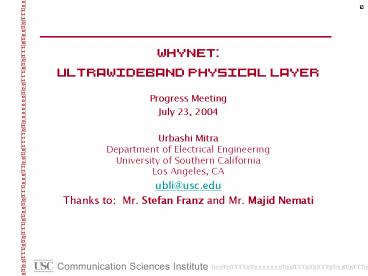WHYNET: UltraWideband Physical Layer - PowerPoint PPT Presentation
1 / 22
Title:
WHYNET: UltraWideband Physical Layer
Description:
Antenna design. Antenna characterization. Propagation measurements ... Effects of antenna on template. Channel estimation. Clean algorithm/efficient search algorithms ... – PowerPoint PPT presentation
Number of Views:40
Avg rating:3.0/5.0
Title: WHYNET: UltraWideband Physical Layer
1
WHYNETUltraWideband Physical Layer
Progress Meeting July 23, 2004 Urbashi
MitraDepartment of Electrical EngineeringUnivers
ity of Southern CaliforniaLos Angeles,
CA ubli_at_usc.edu Thanks to Mr. Stefan Franz and
Mr. Majid Nemati
2
UWB Research Focus
- Testbed Development
- Interfaces with the existing radios
- Simulation platform
- Characterization of physical layer for use at
higher layers - Characterization of radios
- Interface between simulation platform and other
layers in the testbed
3
Leveraging the UltRa Lab
- UltRa Lab currently is predominantly a
measurement facility - Goal is to move to communications and measurement
- Recent activity
- Antenna design
- Antenna characterization
- Propagation measurements
- Propagation Measurement warehouse
4
Timeline and Deliverables
- Year 1
- Assess models for simulation environment
- Simulation code modularized, models collected by
end of Summer 2004 - Integration with ns-type simulator by end of 2004
- Design simple synchronization
- New Transmitted Reference symbol and frame
synchronization scheme designed - Theoretical analysis ongoing
- Procure UWB radios from XtremeSpectrum
- Characterize physical layer performance and
capabilities of XtremeSpectrum radios
5
Freescale Radio Specifications
- Variable data rate
- 25, 50, 75, 100 Mbps
- 1, ½, ¾ coding rates
- 802.15.3 protocol
- DS-CDMA spreading
- BPSK modulation
- Less than 1 mW radiated over 3.1 10.6 GHz
(200mW) - 10m range
6
Wireless Evaluation Kit
7
Signals in UWB
- Transmitted signal has the form
- P(t) is the transmitted template,
- e.g., second derivative of a Gaussian pulse.
- NuNumber of users
- NsyNumber of Tr symb
- NsNumber of symb/data symb
- NfNumber of frames/symb
8
UWB Signaling and Channels
9
UWB Testbed Effort
- UWB physical layer simulation
- Link with network simulator (NS) environment
- C programming
- Different settings and parameter selection
- Simulate different typical channels
- (IEEE 802.15 four UWB channel models)
- Different parameter selections in transmitter
- Different receiver structures
10
Simulation System Diagram
11
Channel Models
- Received Signal
- Transmitted signal
- Channel effects (Multipath, differentiation, etc)
- Narrowband interference
- Filtering (channel, Tx and Tr)
- Channel Models
- CM1 Line-of-Sight (LOS), 0-4m channel
measurement - CM2 Non-LOS (NLOS), 0-4m channel measurement
- CM3 NLOS, 4-10m channel measurement
- CM4 Extreme NLOS multipath, 25 nsec rms delay
12
Basic parameters (adjustable)
- Nsy Number of data symbols/observed interval
- Nd Number of transmitted symb/data symb
- Tsam Template sampling time
- Nu Number of users
- Ts Symbol time
- Nf Number of frames/symb
- Nc Number of chips/symb
- Nh Time hopping seq. max value
- Nr Number of reference symbols
- Delta-samTime of RAKE fingers
- Alpha Fraction of transmitted energy spent for
training and data symbols - Np period of spreading sequence (DS case)
- Bcode Block code being used
13
Clustered Channels
Cramer, Scholtz, Win
in time of arrival versus angle of arrival space,
multipath occurs in clusters
14
Sparse/Clustered Channel models
- Sparse channels versus dense channels
- Accepted channel models based on clusters
- A pragmatic way to reduce complexity and improve
performance (tradeoff between number of
parameters to estimate and amount of data)
we get gains of up to 4 dB by exploiting
clustering
15
Transmitted Reference Systems
- Why transmitted reference?
- Waste of information rate
- Waste of transmission power
- Performance degradation due to noisy template
signal - Advantages
- No explicit channel estimation needed
- High energy capture possible
- Example
- Our optimized TR designs over 4 dB gains over
existing systems
16
Optimized Transmitted Reference
- Significantly improved BER (almost 4dB)
- Approximate receivers perform close to true
receivers - Small degradation for high SNR
accurate (modest complexity) approximations of
performance have also been designed
17
Optimized Integration Interval
- Integrating over the entire delay spread can lead
to 1-3 dB losses in performance
- An optimal integration interval exists
- Yields complexity reduction
18
UWB Timing Synchronization
- Idea Semiblind approach
- Jointly exploit known pilot symbols and unknown
data - Use less pilot symbols
- Take advantage of unknown data symbols
- Transmitted signal
- data symbols
- transmitted monocycle
- time-hopping code
- , frame-time and chip time
19
Symbol and Frame Synchronization
- Semiblind approach
- Jointly exploit known pilot symbols and unknown
data - Use less pilot symbols
- Take advantage of unknown data symbols
- time-hopping code misalignment
- symbol offset
20
UWB Timing Synchronization
- Received signal
- channel response
- delay offset in multiples of the frame time
- delay offset in multiples of the sampling time
- Joint estimate of channel and timing offset
unknown
21
UWB Timing Synchronization
- Maximize likelihood function for and
- Soft-estimates on the unknown data
- Recursive structure since is dependent on
- Backsubstitution and low SNR approximation
- Timing estimates
22
Synchronization Operation
- Maximum likelihood based methods
- Approximations to reduce complexity
function of channel estimate
23
Probability of Synchronization
- Comparsion with DD scheme that uses hard
decisions on the unknown symbols - Semiblind scheme shows significantly improved
probability of acquisition for small number of
training symbols
24
BER for ML and GLRT Receiver
- BER for ML and GLRT receiver approaches perfect
timing case (PTK) - GLRT outperforms ML by about 1dB
- Added cost is complexity

